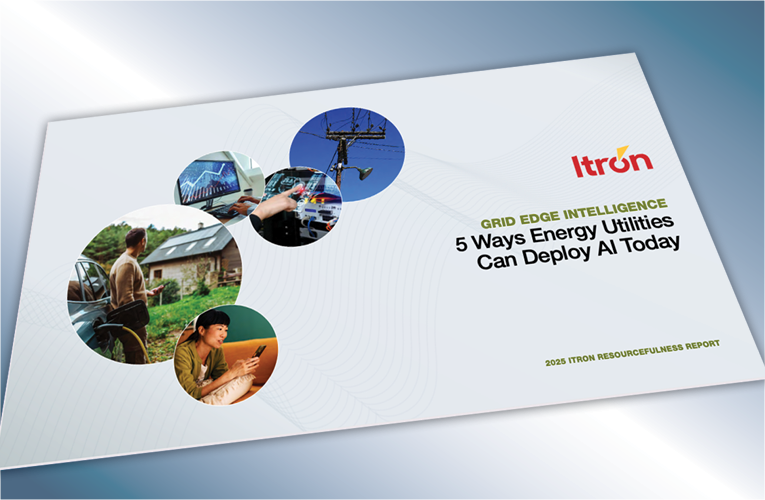
Itron News
Powering the AI Economy: The Intersection of Data Centers and Utilities
The rise of artificial intelligence (AI) has sparked a new kind of energy race that’s redefining how electricity is produced, distributed and consumed. As AI drives record-high electricity demand through massive data center expansion, it’s also equipping utilities with the intelligence they need to keep the grid resilient and reliable.
Findings from Itron’s 2025 Resourcefulness Report, Grid Edge Intelligence: 5 Ways Energy Utilities Can Deploy AI, reveal how utilities are adapting to this intersection between exponential energy demand and the need for smarter grid management. Based on insights from 500 utility executives across the U.S. and Canada, the study shows that 81% of North American utilities have already adopted AI. This far outpaces industry forecasts and represents one of the fastest, most transformative technology shifts the industry has ever seen.
In last year’s study, only 27% of respondents expected AI to be fully integrated within five years. Today, 41% report full integration and another 40% have mature projects underway, signaling a rapid acceleration in AI adoption across the energy sector.
A New Kind of Energy Race
AI adoption is transforming nearly every aspect of the utility industry, from asset management and load forecasting to customer engagement and grid optimization. But it’s also fueling a surge in energy consumption.
Driven by data centers, manufacturing growth and electrification, the energy sector is facing surging demand and a new set of challenges. The “AI economy” has become a powerful load driver, creating what many executives describe as a “trifecta” straining grid capacity across North America.
The Intersection Point: AI Load Demand and Grid Capacity
The numbers tell a striking story. Roughly $876 million is being invested in AI data centers every day, with additional strain from manufacturing expansion and electric vehicle infrastructure. Yet the average U.S. interconnection wait time is four years, and 70% of grid assets are more than 25 years old.
The result? A growing mismatch between the pace of digital transformation and the physical realities of the grid. At the same time, AI is becoming a cornerstone of resilience. Nine in ten utility executives say AI, analytics and grid edge intelligence are “very or extremely important” to their strategy.
From real-time optimization to predictive maintenance, AI provides the intelligence layer utilities need to manage variability, forecast demand and improve operational efficiency, turning data overload into actionable insight.
Five Ways Utilities Can Deploy AI Now
- Grid Optimization: More than half of utilities (57%) cite grid optimization is the area where AI and data analytics can have the greatest impact on their operations. By analyzing system data in real time, AI helps reduce losses, balance distributed resources and accelerate grid modernization.
- Safety: Cited by 53% of respondents, AI is enhancing safety through faster hazard detection and predictive maintenance. From wildfire prevention to equipment inspections, AI enables utilities to act before problems escalate.
- Energy Demand Forecasting: With 51% identifying it among their top AI priorities, forecasting is becoming smarter and more dynamic. AI integrates grid, weather and DER data to improve capacity planning and anticipate demand spikes.
- Customer Experience: As energy costs rise, 57% of executives say customer support is a growing challenge. AI helps personalize communications, automate outage alerts and offer clearer energy insights, strengthening engagement and trust.
- Predictive Maintenance: With nearly 70% of U.S. transmission lines and transformers over 25 years old, 47% of utilities consider predictive maintenance the leading AI use case. AI enables proactive detection of equipment wear and tear and conditions that can shorten asset life.
Executive Signals: AI as Grid Strategy, Not Just Technology
Utility leaders are making it clear: AI isn’t just another technology layer. It’s a core component of grid strategy. Nearly 90% of executives now classify AI and analytics as “extremely/very important” to addressing the challenges facing them, including reliability, resilience and sustainability goals.
Integration between AI and Distributed Energy Resource Management Systems (DERMS) is becoming central to grid economics and regulatory strategy, enabling smarter dispatch, cleaner generation and more efficient customer engagement.
Shaping the Future of Energy
As AI reshapes industries and amplifies electricity demand, utilities are uniquely positioned at the intersection of innovation and infrastructure. The challenge ahead is not only to meet this new load but to manage it intelligently.
By embedding AI and grid edge intelligence into operations today, utilities can turn the challenge of addressing demand into an opportunity to build a smarter, more resilient energy future.
To explore the full findings from the 2025 Resourcefulness Report, Grid Edge Intelligence: 5 Ways Energy Utilities Can Deploy AI, visit www.itron.com/resourcefulness.
Related Articles
HTML Example
A paragraph is a self-contained unit of a discourse in writing dealing with a particular point or idea. Paragraphs are usually an expected part of formal writing, used to organize longer prose.





